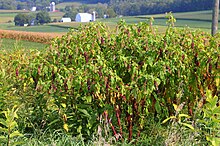Pokeberry
| Phytolacca americana | |
|---|---|
 |
|
| Scientific classification | |
| Kingdom: | Plantae |
| Clade: | Angiosperms |
| Clade: | Eudicots |
| Order: | Caryophyllales |
| Family: | Phytolaccaceae |
| Genus: | Phytolacca |
| Species: | P. americana |
| Binomial name | |
|
Phytolacca americana L. |
|
| Synonyms | |
|
|
| Nutritional value per 100 g (3.5 oz) | |
|---|---|
| Energy | 84 kJ (20 kcal) |
|
3.1 g
|
|
| Sugars | 1.6 g |
| Dietary fiber | 1.5 g |
|
0.4 g
|
|
|
2.3 g
|
|
| Vitamins | |
| Vitamin A equiv. |
(54%)
435 μg
(48%)
5200 μg1747 μg
|
| Thiamine (B1) |
(6%)
0.07 mg |
| Riboflavin (B2) |
(21%)
0.25 mg |
| Niacin (B3) |
(7%)
1.1 mg |
| Vitamin B6 |
(9%)
0.111 mg |
| Vitamin C |
(99%)
82 mg |
| Vitamin K |
(103%)
108 μg |
| Minerals | |
| Calcium |
(5%)
53 mg |
| Iron |
(9%)
1.2 mg |
| Magnesium |
(4%)
14 mg |
| Manganese |
(16%)
0.336 mg |
| Phosphorus |
(5%)
33 mg |
| Potassium |
(4%)
184 mg |
| Sodium |
(1%)
18 mg |
|
|
|
|
|
| Percentages are roughly approximated using US recommendations for adults. Source: USDA Nutrient Database |
|
Phytolacca americana, the American pokeweed or simply pokeweed, is a herbaceous perennial plant in the pokeweed family Phytolaccaceae growing up to 8 feet (2 meters) in height. It is native to the eastern United States and has significant toxicity.
It has simple leaves on green to red or purplish stems and a large white taproot. The flowers are green to white, followed by purple to almost black berries which are a food source for songbirds such as gray catbird, northern mockingbird, northern cardinal, and brown thrasher, as well as other birds and some small animals (i.e., to species that are unaffected by its mammalian toxins).
Pokeweed—also known by a number of other names—is native to eastern North America, the Midwest, and the Gulf Coast, with more scattered populations in the far West. It is considered a major pest species by farmers. Additionally, pokeweed poses a danger to human and animal populations via poisoning; with toxicity levels increasing as the plant matures, and poisonous fruit. This very poisonous purple-red ripe fruit poses danger to children and animals who may want to taste it. For these reasons many support eradication of P. americana. Even so, it is used as an ornamental in horticulture, and it provokes interest for the variety of its natural products (toxins and other classes), for its ecological role, its historical role in traditional medicine, and for some utility in biomedical research (e.g., in studies of pokeweed mitogen). In the wild, it is easily found growing in pastures, recently cleared areas, and woodland openings, edge habitats such as along fencerows, and in waste places.
...
Wikipedia
